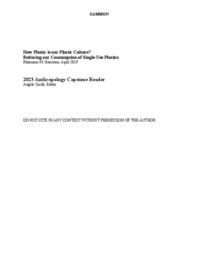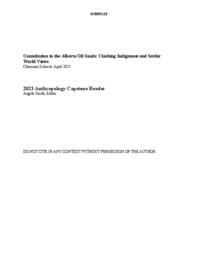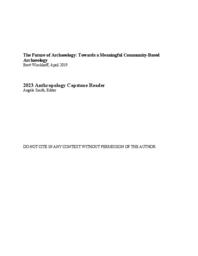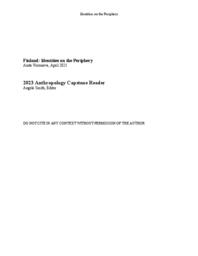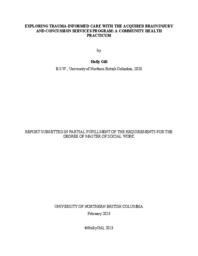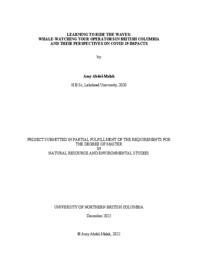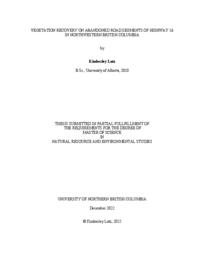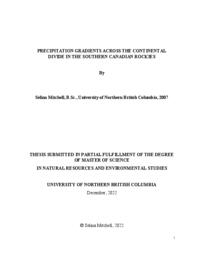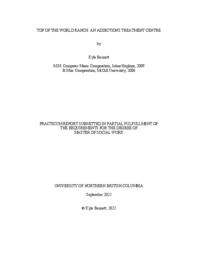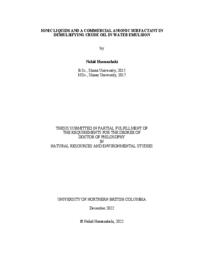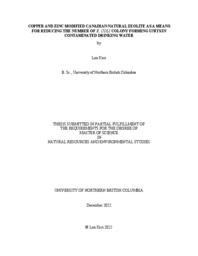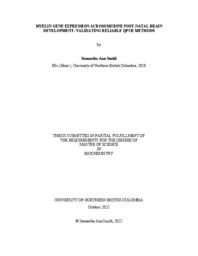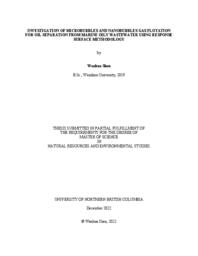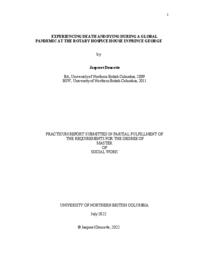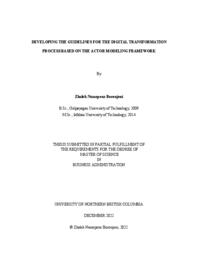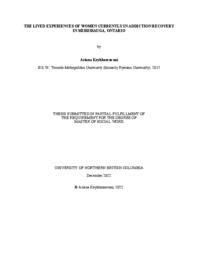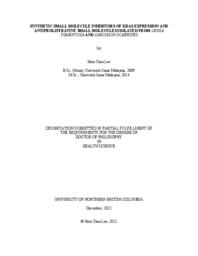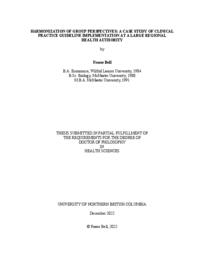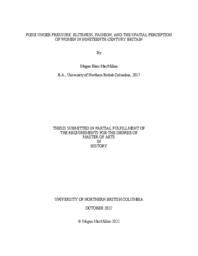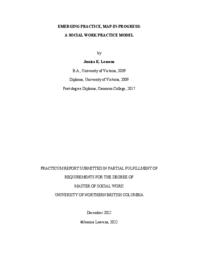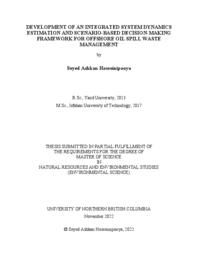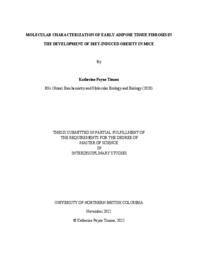University of Northern British Columbia
Related Works
Content type
Digital Document
Description / Synopsis
The ongoing global refugee crisis has been, and continues to be, one of the most pressing humanitarian issues facing the world today. The global trends of destabilization, conflict, and persecution that have been fueling this crisis show no signs of stopping. Clearly, the issues that must be considered are too numerous to cover exhaustively in a single paper. Refugee and migration studies is a vast and complex topic with many specializations and subfields. Thus, for the sake of feasibility and actually generating meaningful information, it seems necessary to focus specifically on both a category of asylum seekers and a country to which they are applying. By doing so, the goal of this paper will be to participate in a more nuanced, and therefore more personal, exploration of a specific set of issues within a specific refugee intake apparatus that may then potentially be used to explore how current immigration systems may be improved. Therefore, this paper shall focus specifically on the experience of SOGI (Sexual Orientation and Gender Identity) asylum seekers, perhaps more commonly known outside of legal documents as LGBTQ+, as they navigate the Canadian refugee intake apparatus.
Origin Information
Content type
Digital Document
Description / Synopsis
Our deep attachment to plastics exists within a complex set of relationships between manufacturers, consumers, markets, and environmental forces. In this paper, I question the reasons behind these relationships and seek to discover why we have become so attached to plastics, and why it is so hard to break this attachment. The effects of plastics extend far beyond the issue of litter, but relate to our construction of identity and our sense of social justice. In this paper, I will argue that plastic is reflective of who we are, and also reflective of the global inequalities we have created and is thus an important social justice issue. I will employ the theory of political ecology to analyze the consumption of single-use plastics within industrialized countries and to untangle these complex relationships. This theory will highlight the influence of finance and power and help to unravel the role of industry and institutions in the seemingly agential decisions we make as consumers. I will then discuss why the plastics problem is so pressing, and why we need to change our culture of single-use plastics. The issue of single-use plastics has widespread global effects, and thus solving the plastics problem is a matter of social justice. I will then apply a political ecological framework to argue that single-use plastics are an integral part of consumer culture, and lie at the core of our identity as a society. Finally, I will turn to the question of how and if our plastic culture is capable of changing.
Origin Information
Content type
Digital Document
Description / Synopsis
Indigenous calls for sovereignty, recognition of ancestral claims, and territorial rights are topics that are becoming increasingly relevant in Canada, particularly as industry continues to put pressure on provincial and federal governments to develop on Indigenous people’s traditional territory. Through the aggressive push for development and extraction of natural resources, two very different ontological perspectives1 of the land are coming into contact, often with the result that projects are delayed and/or brought to the courts, as well as arguably sabotaging efforts of collaboration and reconciliation in other areas of social and political life (Boyd and Lorefice 2018:573). Indeed, the settler-colonial ontological perspective of the land that believes that “any natural resource not used [is] wasted” (Davis 2018:145) conflicts with many First Nations’ traditional systems of stewardship and sustainability (Turner and Jones 2000). As such, a critical space that is worthy of examination is the consultation process because the duty to consult is legally mandated and is one of the few spaces in which the two “ways of knowing” the land come into contact. Accordingly, the research questions which guided my analysis include an examination of how the different ontological perspectives come into conflict when they make contact within the consultation process and what is required for meaningful consultations to take place that accommodate both ontological perspectives. Finding a way to identify and provide solutions to issues of land is of particular importance to contemporary society, as both Indigenous and settler-colonial people draw important connections between the land and their distinct identity and heritage, and neither are going to cede quietly to the other. Further, the need for cooperation is vital in a world where issues of land will become increasingly relevant because of climate change and scarcity of natural resources. In this way anthropology is demonstrably contributing to social issues in society, as the discipline that cultivates the ability to accommodate for, and critically examine, numerous and conflicting worldviews.
Origin Information
Content type
Digital Document
Description / Synopsis
Archaeology and archaeological theory are currently largely in the era of post-processualism. This has been significant as it has changed the ways that archaeologists interact with communities who are stakeholders in community-based archaeological research. However, not all archaeological research has followed suit and in many countries the archaeology still practiced does not include or benefit the local communities. I argue that moving into the future, archaeology must adopt a community-based approach as a mandatory practice in all situations. Community-based archaeology is relatively new in many parts of the world and thus its meaning is still ambiguous. How can we, as archaeologists, do better for the communities we work with and create long-lasting meaningful relationships with them? Community-based archaeology can mean many things and its breadth is part of what makes it so useful, but I argue that it must include meaningful engagement with the source community which leads to a form of heritage-building and empowerment.
Origin Information
Content type
Digital Document
Description / Synopsis
The troubled histories of nations are built from the bones of a million damaged children. But what about the nations and children who are stuck in the periphery between troubled and happy, between damaged and healthy? These are the settings that anthropology can thrive in: nations that have both suffered and benefited from colonialism, oppressed groups discriminating against others, and other ambiguous cultural dynamics. In this paper, I want to focus on Finland as a specific nation that serves as a good example of how collective trauma and ambiguous histories can be contested. These contestations are most commonly expressed through minute inequalities between the two main cultural groups in Finland: Finnish and Swedish-speaking Finns. Modern inequalities between different cultural and linguistic groups in and around Finland are expressed through stereotypes and expressions of identity. These stereotypes and identities are often mixed with ambivalent feelings, especially in regard to Finns' relationship with Sweden: the state and people, both historically and in the present. These relationships are based on the hegemonic and non-hegemonic views that Finnish speakers, Fennoswedes, and Swedes hold of each other. Hegemonically, quiet admiration and casual disapproval are common, hence the ambiguity. Non-hegemonically, extreme emotions and fixations are commonly perceived as strange and distasteful; everything must be just right, or lagom in Swedish. In this paper, I focus the discussion on Finnish issues of cultural and linguistic identity while keeping their relationship with the Swedish state and people in mind. Hence, my goal is to answer these questions: How has discrimination shaped Finnish identities? Has it shaped Finnish-speaking versus Swedish-speaking Finnish identities differently? How does a collective memory of oppression affect Finnish peoples' perceptions of others? However, what I ultimately want to answer is what is the source of Finland’s ambiguous historical identity: were Finns victims of ethnic discrimination or is this a narrative produced by historical revisionism?
Origin Information
Content type
Digital Document
Description / Synopsis
This report focuses on what I learned about trauma and acquired brain injuries during my Master of Social Work (MSW) practicum at Acquired Brain Injury and Concussion Services with Fraser Health Authority (FHA) located in Langley, British Columbia. This in-depth and unique practicum allowed me to practice independently as a MSW student and utilize my clinical practice skills. In addition to highlighting the role of social workers within interdisciplinary teams and delivering services within the healthcare system. The practicum provided the opportunity to explore the experiences of practicing social work within community health settings and compare my experiences to acute social work.
Origin Information
Content type
Digital Document
Description / Synopsis
The COVID-19 era and related restrictions have impacted British Columbia (BC) whalewatching operators and their perspectives on whale-watching and tourism-government relations in BC. Despite the popularity and importance of whale-watching in BC, and its relative freedom from restrictions given its outdoor operations, tour operators had to negotiate dynamic constraints during the COVID-19 era. Federal and provincial government responses to the pandemic directly impacted whale-watching, for example, by changing the capacity or number of tourists allowed per vessel. Restrictions also impacted additional goods and services offered by some tour operators, such as refreshments. Adapting to such changes required a certain agility on the part of operators. Many operators also accessed key government supports such as loans and wage subsidies. This paper is based on a mixed methods research project centered on qualitative interview-based research and analysis. It was also informed by limited participant observation on whale-watching tours. Here, we present data gleaned from virtual interviews with 10 whale-watching tour operators. These operators represent approximately 1/4 of 39 active existing operators on and around Vancouver Island, British Columbia, Canada. We offer participant responses and greater response patterns with respect to: 1) how COVID-19 impacted whale-watching operations in BC, 2) what, if any, pivots or changes operators made in response, 3) which supports they accessed and their evaluations of them, and 4) their perspectives on the future of BC whalewatching. We begin with an introduction to: whale-watching in BC; COVID-19’s impacts on tourism as well as government responses to these; key concepts such as the Tourist Area Life Cycle, and ideas about how tourism weathers crises. We then present results highlighting key barriers, opportunities, and adaptations experienced by the tour operators, emphasizing their own words. We end by considering longer term implications for whale-watching in BC. This paper was written for both academic and applied audiences.
Origin Information
Content type
Digital Document
Description / Synopsis
Vegetation recovery on abandoned road segments of Highway 16 in northwestern British Columbia were examined across a climate gradient. The time since road abandonment ranged from 16 to 57 years on sites sampled. Plant cover on asphalt roads was compared with that found on gravel road shoulders using paired t-tests. Plant cover by growth form was further evaluated in response to climate and other environmental predictor variables using multiple regression ‘best fit’ models. Plant community ordination analysis using nonmetric multidimensional scaling was conducted to describe patterns across study sites in species space along environmental gradients. Key drivers of current plant community composition include time since road abandonment, road substrate type, and several different annual climate variables. The best predictor of vascular plant cover and total plant cover was time since road abandonment, but plant community composition was strongly driven by the coastto-interior climate gradient. Non-vascular cover was more abundant on asphalt roads compared to gravel substrates. Woody plant cover was greatest on gravel shoulders compared to gravel or asphalt road centers. Exotic plant cover was negatively correlated with mean annual relative humidity. Plant diversity and species richness were not driven by the climate gradient but instead reflected more site-specific environmental variables. Primary succession on abandoned roads in this study area may be constrained by continued anthropogenic disturbance post-abandonment.
Origin Information
Content type
Digital Document
Description / Synopsis
Vaccine-hesitancy and vaccine rejection are huge problems facing global public health today. Diseases which were once considered to be virtually eliminated due to widespread vaccination are returning with a vengeance, as cases of measles, mumps and chickenpox pop up and spread throughout Europe and North America. As herd immunity diminishes, deadly infectious diseases spread more easily among vulnerable human hosts. This is all due to the growing trend of purposefully forgoing routine vaccinations. Anti-vaccine communities have been steadily growing online for years, and now wield a potent influence on social media. Widespread access to social media increases the ease with which misinformation about vaccines can spread and reach new audiences across the globe. In this paper, I will be seeking to answer the question: what is the anti-vaccine movement and how does this movement interact with social media? I will also examine what role identity plays in attracting new believers to the anti-vaccine community, if any.
Origin Information
Content type
Digital Document
Description / Synopsis
People in rural settings deal with many barriers to accessing Mental Health and Substance Use services. Living and accessing services in a small community presents challenges which are impacted by an individual, family or a community’s social determinates of health. Many service providers accommodate large geographic catchment area with limited resources. Furthermore, many rural people face barriers to accessible funds or reliable transportation. These disadvantages to equitable access can prevent community members to see a clinical counsellor or to pick up any of the pharmaceuticals that are essential to their treatment plan. There are also ethical challenges with providing counselling services in a rural setting. Conflicts may arise in respect to one’s own social location and dual relationships within professional roles and responsibilities. During my practicum at Canadian Mental Health Association Cariboo Chilcotin, I worked with an adult population for the first time. This experience provided me with a wealth of knowledge of the diverse needs of people at different stages across their lifespan. My practicum lead me to the realization that best practice includes multi-disciplinary collaboration and continued educational pursuits in order to provide services of the highest quality.
Origin Information
Content type
Digital Document
Description / Synopsis
This project examines precipitation patterns across the Continental Divide in the southern Canadian Rockies with a focus on precipitation gradients. This thesis is part of the Storms and Precipitation Across the continental Divide Experiment (SPADE) that occurred between 26 April 2019 and 26 June 2019. Daily meteorological data were also examined between 2011 and 2019. The study area encompassed mountainous topography from the Columbia Valley in eastern British Columbia, to a transect of stations alongside the Foothills in western Alberta, with a range of elevations from about 750 m to about 3500 m above sea level. Local station data were derived from three meteorological stations developed for the SPADE campaign, Nipika Mountain Resort (Nipika), Fortress Junction, Fortress Mountain and a tipping bucket transect. Regional station data were derived from several meteorological station networks with publicly available data. Gridded data included ERA5 and ERA5-Land. Cumulative precipitation amounts were the focus of this study, but temperature, relative humidity, and wind speed and direction were also included in my analysis. The objectives of this project are to examine relationships between precipitation gradients/patterns and elevation, cool and warm seasons, general wind patterns/storm trajectories, and inter-annual and intra-annual variability. Elevation is a predictor of precipitation amounts in our study region, and over most time-frames it was a stronger predictor than latitude and longitude in determining precipitation amounts, but the relationship between elevation and precipitation was not always significant. On average precipitation increases at a rate of 0.39 mm m-1 across the study region when it is examined across an annual period. Warm (summer) and cool (winter) seasons exhibited distinctly different precipitation gradients. A southerly wind component at Nipika was associated with large amounts of precipitation at this site.
Origin Information
Content type
Digital Document
Description / Synopsis
Mental Health affects one in five people in Canada (Statistics Canada, 2022), many of whom will seek treatment at a residential center with support for those recovering from addiction. This paper presents my Graduate Practicum Report completed at an Addictions treatment center, the Top of the World Ranch (TWR), located in the East Kootenays of British Columbia. The practicum was focused on addictions, mental health, and counselling modalities as they apply to the context of addiction, with the goal of applying skills and modalities studied in the course work of my MSW preceding this final practicum. After reviewing mainstream and holistic modalities like Cognitive Behavioural Therapy (CBT), Dialectical Behavioural Therapy (DBT), shinrin yoku, visualization, and meditation, I assembled a strong set of tools to offer value at an addiction treatment center with a focus on trauma informed practice. Key learnings in this report include the usage of art therapy and visualization as effective tools in recovery from addiction. I also found a meaningful way to integrate music into my personal therapeutic approach. Additionally, I found programs that involved visualization and meditation to be both an enjoyable way of working and extraordinarily helpful for clients’ recovery process. My practicum at the TWR was one of the most important learning experiences of my life that will inform all that I do moving forward in my career as a counsellor and social worker.
Origin Information
Content type
Digital Document
Description / Synopsis
Crude oily wastewaters generate widely in industries and marine oil spill operations. Crude oily wastewaters contain stable oil in water emulsion (O/W), and their treatment has been challenging. Crude oil has toxic compounds for humans and the environment, and effective treatment requires meeting environmental regulations. This dissertation aimed to investigate effective and environmentally friendly demulsifiers (commercial anionic surfactant and ionic liquids) in demulsifying stable O/W emulsions. Firstly, the O/W emulsification process by ultrasonic homogenization was conducted to optimize the processing parameters and determine the required energy to generate stable emulsion, which is applicable for enhancing crude oil demulsification. The optimum condition to generate stable emulsion was at a power level of 76–80 W, sonication time of 16 min, water salinity of 15 g/L NaCl, and pH of 8.3, which required 60−70 kJ energy. Secondly, the commercial anionic surfactant showed high efficiency (99%) in demulsifying O/W emulsion at the concentration of 900 mg/L in a short shaking time (15 min) at room temperature (25 °C). It could reduce the total extractable petroleum hydrocarbons in the separated water to <10 mg/L without gravity separation and achieve promising demulsification performance at high salinity (36 g/L) and various fresh and weathered oil concentrations. Thirdly, ionic liquid with hydroxyl functional groups on the side chains effectively demulsified O/W emulsion (92%) stabilized by natural emulsifiers (e.g., asphaltenes) at a low concentration (25 mg/L) and room temperature without settling. Hence, the hydroxyl functional group is a suitable substitution for the alkyl group on the ionic liquids side chains to reduce ionic liquid toxicity. It was also found that its potency was highly affected by the emulsion type (stabilized by natural emulsifiers+Tween 20), in which demulsification efficiency reached 61% at the ionic liquid concentration of 50 mg/L and the demulsification temperature of 50 °C at 90 min gravity separation settling time. This indicated the synergistic interaction of natural emulsifiers and Tween 20 and the formation of thicker film at the oilwater interface, which affected the ionic liquid performance. Finally, comparing the performance of three ammonium-based ionic liquids with a distinct side chain (alkyl, ester, and amide) in demulsifying O/W emulsion, it was found that ionic liquid’s side chain and hydrophilicity greatly influenced their performance in the demulsifying O/W emulsion. Substitution of the hydrophobic alkyl group with the hydrophilic amide or ester groups to reduce ionic liquid toxicity improved the ionic liquid potency in the demulsifying emulsion. Ionic liquid with the amide group on the side chain resulted in the highest demulsification efficiency (94%) compared to ionic liquids with the ester (91%) and alkyl (88%) groups at the ionic liquid concentration of 25 mg/L and settling time of 15 min at room temperature, indicating the superiority of the amide group in the demulsifying O/W emulsion.
Origin Information
Content type
Digital Document
Description / Synopsis
Clean drinking water is essential for all life on Earth. Over 400, 000 people die annually from lack of clean drinking water, and the demand on water is predicted to increase in all sectors. The demand for safe drinking water presents an ongoing challenge for new water purification techniques. Since the 1950s, natural zeolite has been investigated as a means of water purification due to its stable, crystalline, porous structure and cation exchange capacities. Recent publications have indicated that natural zeolite modified with metal cations provides a stable treatment media for the elimination of E. coli bacteria in drinking water. In this series of analysis, Canadian natural zeolite from the Bromley River Valley, Kamloops BC, was modified with zinc and copper sulphates to create three novel water treatment options. Treatment of E. coli contaminated water was most effective with zinc modified zeolite, which also significantly lowered the pH in comparison to the copper and copper/zinc modified zeolite. Of the three zeolites, all released too much copper and zinc into solution that may be linked to the low cation exchange capacity (CEC) of the Canadian zeolite. E. coli colony forming units were reduced; however, they were not sufficient to meet drinking water standards. Future studies will focus on optimizing the ratio of modified zeolite needed to treat a given amount of pathogen in solution.
Origin Information
Content type
Digital Document
Description / Synopsis
Myelination is essential for proper conduction across all neural networks. Myelination in the central nervous system is performed by glial cells called oligodendrocytes. Mature, myelinating glia develop from progenitor cells through distinct differentiation steps, and gene expression markers have been established that are unique to oligodendrocyte lineage cells. This study aims to establish a reliable RT-qPCR protocol to quantify oligodendrocyte-specific gene expression according to the MIQE guidelines. Primers specific to the progenitor, immature, and myelinating stages of oligodendrocyte differentiation were validated, showing 90-100% efficiency. Reference gene primers were also validated, and their stability was determined to make recommendations for those to use as normalization factors. The expression pattern of oligodendrocyte-specific genes across stages of postnatal development was similar to previously defined RNA-seq profiles in isolated cell types. The validated RT-qPCR assays developed build a framework for future investigation on myelination during development and remyelination in disease.
Origin Information
Content type
Digital Document
Description / Synopsis
Oily wastewater caused by marine oil spills brings great harm to the environment. In this work, the application of gas flotation with microbubbles and nanobubbles in separating crude oil droplets from oily wastewater is reported. The experiments were conducted in a flotation column with an internal diameter of 5.2 cm and a height of 100 cm. Response surface methodology was employed to examine the effects of three experimental factors (initial oil concentration, flotation time, and temperature of inlet wastewater) on the oil separation performance and the interaction between experimental factors. A good agreement was obtained between the predicted and experimental data of oil separation efficiency, with a high R2 of 0.99 and an adjusted R2 of 0.98. The optimization results demonstrate that the maximum oil separation efficiency (98.3%) was achieved under optimum experimental conditions of 524.5 mg/L initial oil concentration, 28.6 min flotation time, and 21.2°C inlet wastewater temperature.
Origin Information
Content type
Digital Document
Description / Synopsis
This practicum report is a summary of my experience at the Prince George Rotary Hospice House and a reflection upon the death and dying process during a global pandemic. Aspects of my practicum report are explored via a literature review, time spent at Hospice House and self-reflection on my personal and professional framework. My experience at Hospice House provided me the opportunity to witness death and dying in a home-like environment with full supportive care where the focus was always the guest and family. During this practicum I had the opportunity to wholeheartedly connect with people as they transition into another phase of life while I also supporting families during this difficult time. A common theme that provided comfort to the hospice care team was that perhaps the dying person was transitioning into a beautiful world where their family and friends await their arrival. The knowledge I gained from this practicum will continue to support my professional practice in acute care, where death and dying are predominate. As I continue my social work journey I am reminded of being open-hearted, being present in the moment with people as they are in pain, and acknowledged that being a part of someone’s dying journey is an honour.
Origin Information
Content type
Digital Document
Description / Synopsis
Many companies use information systems to support their operations, but to properly utilize IS, organizations must go through a Digital Transformation (DT) process. One of the strategic assets needed to begin or accelerate the DT journey is Dynamic Capabilities (DC). Despite the progress that DT has achieved in understanding the contributions of individuals to the construction and maintenance of DC, there have been requests to engage more deeply with the nature of the work performed by actors who support these capabilities. Therefore, we focus on the actors' roles in DC and use the Actor Modeling Framework to connect actors to DC. Then we developed a guideline by using a design-science approach to connect different parts of DT, and its application was tested in Prince George, Red Deer, and Grande Prairie EDOs. The guideline is like a clear map showing EDO organizations where they need to go to implement DT.
Origin Information
Content type
Digital Document
Description / Synopsis
This research explores women's experiences in recovery from addiction in a suburban area of Mississauga, Ontario (ON). In the suburbs drugs are not as localized as they might be in a city. The goal set out in this research was to better understand recovery from the women’s perspectives as well as identify barriers, challenges, and benefits they faced in recovery and treatment programs. The research offers suggestions on how this information could be considered when creating or adapting current recovery and treatment programs. The research may also help us understand and improve women’s entry, retention, and completion of treatment programs. Six participants participated in semi-structured interviews, four in person and two over the video platform Zoom due to the COVID-19 pandemic. Thematic analysis was conducted and four themes emerged: opinions on treatment programs, cravings and withdrawals, support, and recommendations to improve treatment programs.
Origin Information
Content type
Digital Document
Description / Synopsis
Small molecules, including synthetic and those isolated from natural products, are important classes of compounds with broad utility, including drugs. The objectives of this dissertation were (i) to synthesize, purify, and characterize novel small molecule inhibitors on KRAS expression level; (ii) to purify and characterize antiproliferative small molecules from Onnia tomentosa and Sarcodon Scabripes. The first part of this Ph.D. dissertation focuses on synthesizing dispiropyrrolidizine derivatives with potential KRAS protein expression inhibitory activity. At the outset of this study, compound UNBC 152, which turned out to be a mixture of compounds, was found to possess bioactivities including antiproliferative activity and the ability to inhibit KRAS expression. This study aimed to synthesize UNBC 152 and resolve the compound-activity ambiguity. The investigation on UNBC 152 led to the isolation of two novel regioisomers, 6 and 7. Regioisomers 6 and 7 were synthesized using a one-pot three-component 1,3-dipolar cycloaddition reaction. They were purified using recrystallization method and their structures were determined by FTIR, ESI-LRMS, NMR, and X-ray crystallography. Regioisomers 6 and 7 showed the ability to inhibit KRAS protein expression. Over the past several decades, researchers have isolated many useful medicinal compounds from mushrooms. Medicinal mushrooms with validated anticancer properties in animals have been found and this has encouraged further exploration of fungal metabolites with antiproliferative activity. The second part of this Ph.D. dissertation focuses on isolating antiproliferative small molecules from two species of mushrooms native to British Columbia (BC). Chapters 3 and 4 described the use of antiproliferative activity-guided approach that led to the isolation and structural elucidation of small molecules from O. tomentosa and S. scabripes native to Northern BC. The ethanolic extracts of O. tomentosa and S. scabripes were purified using phase separation, Sephadex LH-20, and HPLC-based fractionation. The final structure of the small molecules was determined by ESI-LRMS, ESI-HRMS/MS, and NMR. Fatty acids (labeled 1.1-1.4 and 2-7) were identified from the ethanolic extract of O. tomentosa, while several p-terphenyl derivatives (1-4) and one phenolic aldehyde (5) were identified from S. scabripes. Amongst the small molecules, oleic acid (7), linoleic acid (6), and linoleic degradation products from O. tomentosa, and compounds 1-5 from S. scabripes showed antiproliferative activity against HeLa cervical cancer cells.
Origin Information
Content type
Digital Document
Description / Synopsis
Policy makers, health industry leaders, clinicians and researchers struggle to understand how new evidence-based practices, including Clinical Practice Guidelines (CPGs), can be implemented more quickly and more consistently. This retrospective qualitative case study explored sepsis CPG implementation at a British Columbia Regional Health Authority (RHA) between 2011-2017 to understand how individuals and teams with various functions and decision-making purviews come together to implement a prioritized CPG in a large RHA. The study was informed by practice theory and designed to provide practical guidance as to how CPG implementation might be better supported. Interviews involved 38 participants reflecting three functional groups: academics, regional managers and support staff, and clinicians. Over 350 documents and implementation process and outcome data were analyzed. The CPG implementation process was dynamic, involving different activities and intensities of involvement of individuals from each of the three groups. The three groups each behaved in a manner consistent with what some practice theorists call a community of practice. Individuals from each community of practice (COP) had a different perspective about the implementation along five dimensions (focus and rationale, vision, priority, appropriate balance and application of power, and goals, strategies and actions to be taken). The different COPs undertook actions that were consistent with their own COP perspective but not sufficiently aligned to ensure adherence to the CPG. The result was a discordant, and unsuccessful implementation. CPG adherence was not achieved. The differences in perspectives among the three COPs were substantial and appeared to have been deeply rooted in the beliefs, functions, experiences, and day-to-day realities of each of these groups of participants. The discordance in the implementation resulted from an insularity of each COP from the others, brought about by inadequate engagement among participants; insufficient connections across COPs to support shared understanding and alignment of action. Without some intervention, differences in perspectives will prevail and discordance is the likely outcome of any complex CPG implementation. This dissertation proposes the novel concept of harmonization as a means of achieving more successful CPG implementation; a process intended to reduce insularity of individual COPs within and beyond a RHA. Harmonization is conceptualized as a process comprised of many harmonizing activities that support engagement, relationship-building and explicit reflection and reconciliation of key differences in perspective among the three COPs. As a relational process, harmonization is largely determined by longstanding, contextual factors that support connections and collaboration among COPs. Widely engaging, horizontal, service-oriented improvement structures (with clear supporting roles and processes) establish a foundation for harmonization. Ongoing local interprofessional learning and improvement activities are essential to ensuring that the service improvement benefits from strong clinical engagement. RHA managers, particularly clinical managers, can support harmonization by encouraging open sharing of perspectives and managing in a way that is responsive to the realistic ebbs and flows of the implementation process. Harmonization integrates and builds upon many known CPG implementation determinants and strategies to bring a practical focus for future research and action.
Origin Information
Content type
Digital Document
Description / Synopsis
Every summer thousands of Britain’s elite upper class travelled to London’s West End to socialize and participate in the Season. During this time, elite women donned luxurious court gowns and went to St. James Palace to present themselves before Queen Victoria in Drawing Room ceremonies. One of these gowns, from 1863, survives today and offers an evocative glimpse of how elite women styled themselves for one of the most important ceremonies in their life. But, the West End was not just an elite neighbourhood. It also housed and employed middle and working-class Victorians with whom the elite did not always happily coexist. In 1861, peer and M.P. Sir Shelley allegedly flashed the public and his middle-class neighbours while a carriage procession for one of the Queen’s Drawing Room ceremonies passed below. The Times reported his trial, which featured contemptuous cross-examinations of several working-class women, and Sir Shelley’s triumphant victory. Two years later, several elite men submitted letters to the editor of The Times, complaining about the cramped and sometimes combative atmosphere of royal ceremonies, suggesting that they were not safe for women to attend. There is a gendered conflict in these sources. Those from elite feminine perspectives show the value in attending royal ceremonies, during which women could use their fashion and occupation of space to reinforce or manipulate their social status. The documents written from men’s points of view, however, show an attempted renegotiation of elite status by excluding the middle class and further limiting women’s access to elite spaces. My research questions where this conflict originated and how historians can utilize less traditional sources to bring feminine perspectives into areas of history in which male points of view have often dominated.
Origin Information
Content type
Digital Document
Description / Synopsis
As social workers, we develop our own integrated social work theory and practice model to guide an ethical, accountable, and evidence-based approach to professional practice. This report describes my emerging model, a map-in-progress, developed over the course of my Master of Social Work degree and final practicum. My practice takes place in the territories of the Tla’amin Nation. In this report, I focus on social work in primary health care, grounded in a theoretical orientation of Just Practice, queer theory, and abolitionist theory. I describe four landmarks generated in the context of my practicum: i) interprofessional practice, ii) the clientpractitioner relational continuum, iii) equity-oriented health care, and iv) abolitionist social work. I present a series of process-oriented collages rooted in the tradition of arts-based inquiry as selfreflexive practice. This report serves as a tangible touchstone for my emerging practice and I offer it as a humble addition to social work scholarship and practice.
Origin Information
Content type
Digital Document
Description / Synopsis
Managing the waste generated after response operations is the most challenging part of an offshore oil spill. A waste estimation is required before deciding on the transportation, treatment, and disposal of each type of oil spill waste. So, firstly, this thesis developed a system dynamics model to estimate the quantity of each type of oily waste generated after oil spill response operations, considering different aspects (e.g., weather conditions, the spilled oil volume and characteristics, response time and equipment). The results of the model for an actual oil spill in BC, Canada (2016), as the case study, showed a 86% average accuracy. Sensitivity analysis of the case study illustrated that a five-hour decrease in the response arrival time could increase the oil recovery by 26%. Moreover, sensitivity analysis showed a possibility of 45% overuse of sorbents for the case study. Response surface methodology (RSM) also was conducted, and the significant interaction effects between sea temperature and response arrival time on recovered oil and between sorbent boom weight and sorbent booms usage rate on solid waste were demonstrated. In addition to the oil spill response waste (OSRW) quantity estimation model, the study developed a scenariobased decision-making framework as the second objective to provide the most monetary beneficial strategies to deal with each collected OSRW under different scenarios of impact factors (e.g., waste quantity, waste quality, location, capacity, and availability of treatment and disposal facilities). An optimization model with an objective of minimizing net costs was developed to evaluate all scenarios using hypothetical and actual data. Results were categorized to develop the decisionmaking framework. It was illustrated that oil processing is the best option for managing liquid oily waste from spilled refined oil. For liquid oily waste from crude spilled oil, the oil refinery is the best option if the quantity is above a defined limit in this study. For solid oily waste management, pyrolysis is the most appropriate destination. The optimum solutions and sensitivity analysis for the actual data of a case study validated the results.
Origin Information
Content type
Digital Document
Description / Synopsis
Obesity harms the health and quality of life of millions of people worldwide and places financial stress on patients and healthcare systems. The metabolic breakdown and development of disease, such as type 2 diabetes, that occurs with obesity has been shown to be largely driven by adipose tissue dysfunction resulting from adipose tissue hypoxia, adipocyte death, macrophage infiltration, and fibrosis. The early stage of adipose tissue fibrosis is poorly understood, particularly in female mice. To identify the initiating molecular changes in adipose tissue fibrosis we have measured the expression of a suite of molecular targets crucial to the development of adipose tissue inflammation and fibrosis in obesity including tumor necrosis factor-alpha (TNF-α; early inflammatory and insulin resistance driver), transforming growth factor-beta (TGF-β; pro-fibrotic cytokine), collagen VI (abundant in fibrotic lesions), matrix metalloproteinase-14 (MMP-14; key extracellular matrix protease in adipose tissue), and tissue inhibitors of MMPs 1-4 (TIMPs 1-4; modulators of proteolytic activity). The first part of this work details the development of a murine model of diet-induced obesity, early insulin resistance, and adipose tissue fibrosis without diagnosable fibrotic build-up quantified with picrosirius red. The second part of this work shows early changes in the expression of key inflammatory and fibrotic components in adipose tissue, including mRNA upregulation of TNF-α, TGF-β, and collagen VI in both sexes, as well as upregulation of TIMP-1 in male mice and TIMP-4 in female mice. Collagen VI immunoreactivity in visceral adipose tissue is also increased, but only in males. These molecular changes are conducive to the development of a fibrotic milieu and represent the initiating steps in adipose tissue fibrosis. This work has improved our understanding of the molecular processes in obesity development and highlights potential targets for therapeutic intervention in the treatment of obesity and metabolic disease.
Origin Information


